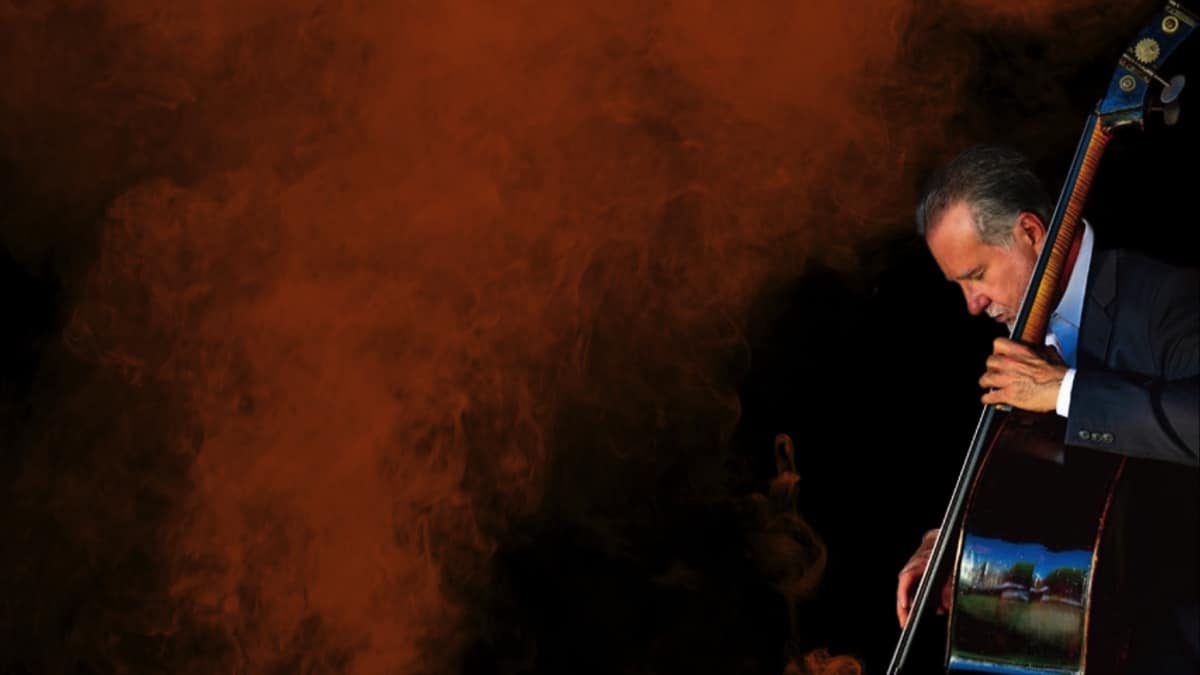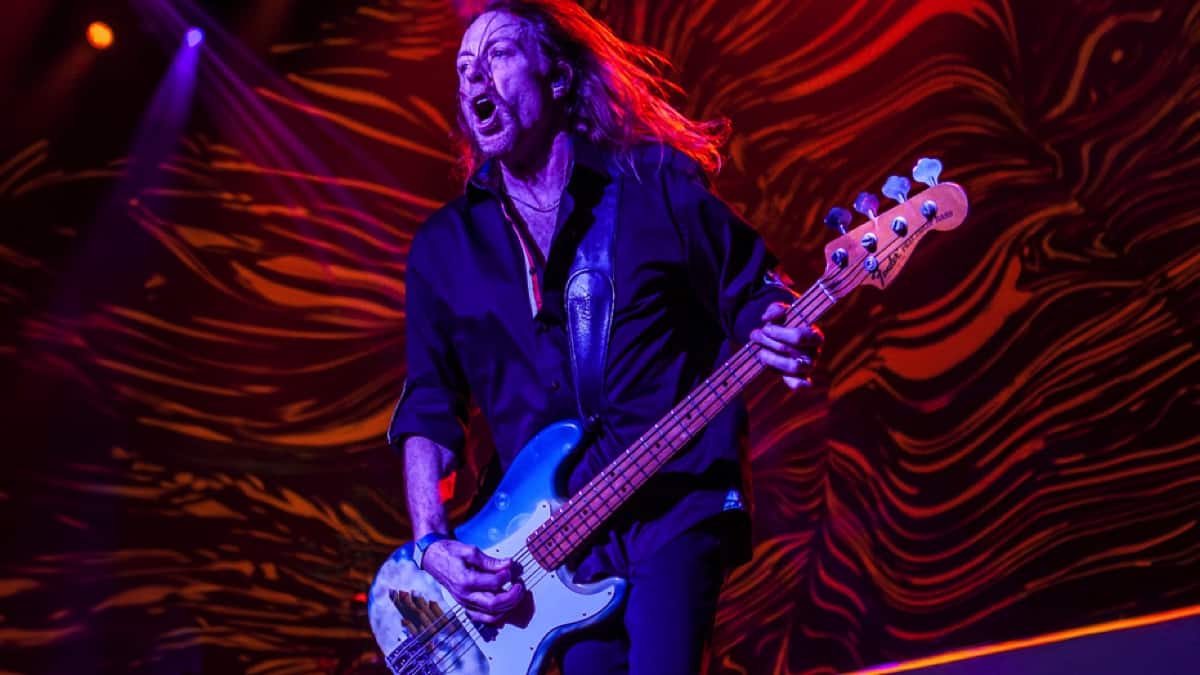Cover
ERB Legend Stewart McKinsey – Bass Musician Magazine, December 2016 Issue


Photo, Jillian Carlson
ERB Legend Stewart McKinsey
Stew has been a silent, driving force in the ERB player community for many years, a skilled ERB columnist and probably the first dedicated 10-String ERB bassist ever. He’s a highly introspective person, which is probably the reason why we don’t see him very often hitting the stages. At the same time Stew is a very humble person and highly intelligent, prepared musician. We kindly invite you to know more about him…
Please tell us about your musical background and that crucial moment when you decided to move into the ERB field.
I don’t really come from a musical family, but my parents always encouraged me to follow my heart and do the things I believe in. At the same time we always had an incredible array of music playing in my house. Some days it was the Beatles or Blood, Sweat and Tears, but just as often it would be Thelonius Monk, Ravi Shankar or the orchestral work of any number of composers. My mother always took us to museums, plays and musical; she encouraged us to be the most well-rounded people we could be. I owe my parents so much!
ERB was a very natural progression for me. I remember seeing a picture of Jimmy Haslip with a 5-string Yamaha in a full-page ad in one of the music magazines in the 80’s and I was mesmerized. If it was possible to play deeper notes than the 4-string, I wanted more range! Then of course I heard Anthony Jackson and Jimmy Johnson and knew that was for me.
It was years before I found a 5-string, though. There were so few being made then and it was a new field. Even finding strings was a challenge.
When I got to music school, my tutor saw what I was doing, heard my compositions and suggested I look into 6-string bass. At that time there were not even a handful of guys playing them, but Steve Bailey was one of them and he was also one of my teachers. He sold me my first 6. I got it set up and took it home to play. It had been in my hands less than 20 minutes when the thought came into my head: what if I had one lower string and one higher string? That was 1988 or 1989 and EVERYONE that I talked to about the idea thought I was crazy, but I have never looked back.
What would you say to all those ERB haters around?
Well, I know from first hand experience that they will not listen, but if they did… I would tell them to focus all that negative energy and create the art that inspires them. It is easy to be cruel, but creating is a noble pursuit. I’m not a great artist but the challenge of putting my heart into something, whether I share it or not, lets me feel like my life is about more than breathing and sleeping. I teach when I’m not composing, practicing or playing, and if there’s a chance I can help someone develop into the musician he or she wants to be, I feel I have done some good. Who knows what life is really about, but it is short. For me it’s too short to be cruel.
In your opinion, what are the benefits and downsides of playing with an ERB?
Personally, I love the challenge and the freedom extended range offers me. Being able to explore chord voicings and the different timbres across the 6+ octaves opens me as a composer.
One of the big benefits is that I am far more comfortable when I’m asked to play a 4, 5 or 6-string bass, which is a benefit as a teacher as well. Having to refine things like my muting technique as well as really focusing on what I want to do as a musician on the big beast gives me some clarity in terms of finding my voice.
One of my favorite things about ERB is that there are so many great stylists. I love Yves Carbonne’s lyricism and humor, Jean Baudin’s introspection and exploration, Al Caldwell’s virtuosity and being able to speak as if using dozens of instruments… I get endless inspiration from this community! And with players like Scott Fernandez coming up now and blowing people’s minds by regularly doing things that are physically impossible, the future is in good hands.
If there is a downside it’s that players who use more than 6 strings are still being met with open hostility. The number of jokes I hear every day about harps, pianos, aircraft carriers, surfboards, guitars and who knows what is frightening. And of course there are more vulgar and personal comments. I used to wonder if Narciso Yepes had to deal with these kinds of things and I recently found out he did.
What’s worse, and most strange, is that these things only seem to come from within our community. Keyboard players, drummers and guitarists actually like our instruments. I have done duet performances with vocalists and no one in the audience ever approached me to make a nasty comment… unless it was a bass player. So the challenges are there, but I feel are worth it. If one wants to explore, explore! Let those with small and closed minds live in the worlds they choose. We can make music regardless.
How do you take care of the string-muting and string-spacing issues?
Initially, I approached it purely from a standpoint of technique. Steve Bailey was adamant that one needs solid technique as a foundation for everything we do and I believe that. I work hard to keep from developing bad habits but I accept that I’m human and that is also a part of my voice. I don’t believe in perfection. Perfection is not human. But if I can keep reasonably clean technique, that is one less thing to get in the way of making music, one less thing to think about so I can simply play.
With the biggest basses, the 10-string monsters, I use a FretWrap from GruvGear. This was a logical development of the ponytail holders that many of us used once upon a time, and it’s a brilliant tool. At the same time, I think it’s important to be able to function without one and I make sure when I practice to allot a certain amount of time to going ‘au naturel’ and letting the strings and my fingers negotiate without the mute.
Please tell us how your extended range bass has evolved through the years.
One of my teachers was Gary Willis and he had this beautiful Tobias bass with no controls. I asked him about it, as I was taken by the look but curious about his idea. He told me that he wanted to have his hands as the volume and tone controls, instead of having electronics color the sound. That idea really stuck with me and has been at the heart of what I do on ERB. Of course everything between my brain and the point where vibration is sound as it leaves my speakers is an element in the tonal equation, but the idea of simplicity and purity on a sonic level appeals to me. I don’t often use effects. So for me it’s always about paring down, getting rid of excess. I understand so much more about tone and the factors in it now than I did as a younger player, but so much of it is in the hands.
Each instrument has taken this idea in a different direction, so each instrument has had a different goal in terms of sound and function. While I’ve been fortunate to have some stunningly beautiful basses, each has been crafted in collaboration with the builder. So I start by talking about the sound I’m after and what I hope the instrument will be able to do and we discuss woods, pickups, construction methods and all the details until we are both happy with it. Bill Conklin is a brilliant collaborator and each instrument grows out of a real dialogue.
Along similar lines I figured out pretty quickly what point to stop in terms of string count. I found myself getting lazy and complacent on an 8 string and 10 is always scary. Also I’m not a really big guy, so physically this is about as far as I want to go since I’m not getting any younger.

Photo, Dennis Deja
Please tell us about the evolution your ERB playing technique has experienced through the years.
Again, in my case refinement is simplification. As a younger player I wanted to be able to do everything. To play fast with deep grooves, have a great chordal vocabulary and be a brilliant soloist with the kind of chops that scare people. Eventually I realized that those aren’t the things I listen to and the music I love, while it may have impressive elements, is really is music from the heart. It’s almost never about the wild technical stuff. So I find I’m always stripping away. I want to say more with less, to fall back on the cliche. But when I realized how important space is in music, I started reevaluating everything I did.
One of the tunes that just messed me up and continues to is Weather Report’s amazing “Procession”; what Victor Bailey did is paradigm challenging. Getting past his spectacular tone and the amazing confidence with which he played everything, for the first two-thirds or three-quarters of the piece, he is doing all the things we’re taught not to do but making the music HAPPEN. He avoids two and four like they’re uranium, playing melodic figures and playing with dynamics so that some notes are whispers and some just whomp you. But the feel is incredible. And you wait to hear just what he’s going to tease you with next. When the actual groove kicks in it’s lethal but that play at first, that implying rather than stating things explicitly, is the kind of brilliance that separates musicians from instrumentalists.
I am still working to be able to do that with my music and my playing. ERB gives me an orchestral palette with its great range and still allows me to dig in and play nasty James Brown grooves, so the evolution is ongoing. My music grows simpler and things like note choice, phrasing and tone have become much more important to me. I’m still after my voice, but the physical process of coming to terms with the big basses helps me to refine it. The basic challenges all feed into my clearing that vision.
What do you think is the turning point in your career as a bassist and what do you consider your main contributions to the bass scene? In other words what do you consider your legacy?
For me the turning point was the night I got up and jammed with a singer and afterward the owner of the place asked me if I’d consider having a regular performance at his establishment. I’d never considered playing a solo show even though I’d been writing music for decades and recording solo bass pieces as long. Two weeks later I played my first solo show and while it was terrifying, the applause and the roar of the audience after I finished the first number cemented my path. It was probably one of the most validating experiences of my entire life so far.
If I’ve made any kind of contribution it’s probably that one doesn’t have to be a virtuoso to make heartfelt and genuine music. And one can be an artist even while looking — or sounding — silly. Music is a spectrum, from stripped down and basic to virtuostic and terrifying. And there is a place for all of us along the spectrum. The players who have inspired and influenced me have been guys like Jaco, who reached a level I would not be able to if I had 3 lifetimes to develop my art and craft, but it’s not about becoming our heroes. It’s about taking inspiration from them to become who we’re supposed to be. My friends are all scary, scary musicians and I am honored to be mentioned alongside them, but what I do is not that kind of brain melting magic. I take in just a few seconds of Igor Saavedra or Steuart Liebig and I marvel at what they can do. But instead of being sad or frustrated, I let it become fuel to keep working to develop my voice.
If I have a legacy in our community, it’s to let players know that it’s okay to be your own player. We are not our heroes. We are ourselves.
What would you say to those young musicians who’re considering at this moment going into the ERB world but are still not quite sure about doing so?
If you’re curious at all, try it. There is nothing worse in life than wondering about something but not trying it for fear. Then you have regret. As I mentioned before, life is short. If you think that you might be an extended range bassist, find out! There is no harm in trying. How did any of us discover our favorite colors or foods? We investigated. People will always be happy to tell us who we should be or their idea of what’s right, what’s acceptable. But as an artist, truth is a very individual thing. If you talk with anyone who’s accomplished anything in life, you hear the same thing: they faced and overcame challenges. They didn’t sit and wonder.
If you discover that ERB isn’t who you are or what you want, then you are closer to your own truth! I have heard musicians I adored on the instrument who went on to another instrument or even gave up music. It is about finding our way, not fulfilling someone else’s idea of what we should do.
Curiosity is great. Discovery is better.
Please let us know about the specific elements of your gear.
I favor basses with a 34” scale and a fourths tuning, generally C#-F#-B-E-A-D-G-C-F-Bb. I’m known for having pickups wired straight to the output jack, so no volume or tone controls.
Although I’ve used many instruments over the years, my closest association remains with Conklin Guitars and this year Bill has been making me a very different instrument from any I’ve had in the past, something more representative of his artistry than anything he’s built for me before and what I hope will draw me in new directions as a solo artist.
My speakers have been made exclusively by AccuGroove for more than a decade and an endorsing artist for GruvGear and of course Nordstrand Pickups. My association with Carey Nordstrand has opened my ears to what an instrument can really do when it’s designed and built properly, as well as how important the electronics can be in letting an artist express him or herself.
I have also been fortunate enough to be associated with Bee Basses, Wyn Guitars, Prat Basses, Malekko Heavy Industries, Pigtronix and some of the biggest names in our industry.
Finally, what do you see as the possible evolution of our instrument?
The beauty of what we do is that electric bass is among the youngest instruments on earth. Its vocabulary is still developing. Extended range bass is so young that each player is contributing to its vocabulary! Players like Curtis Reilly are doing things and approaching ERB in a way that I could never have envisioned and there are hundreds of players out there who are still completely unknown.
I remember sitting in a room with Yves Carbonne and Jean Baudin more than 10 years ago and we were talking about our finger exercises, how we could incorporate theory into them, teaching, learning and making music in general. Yves was working on a strumming technique, which would later be featured prominently in his tune “Inside Colors” and Jean was showing us some ways to play sweeps, as well as incorporating whole tone scales into traditional diatonic music. In that moment I knew that the future was wide open and that what we would see and hear in our lifetime as musicians was nothing we could predict. Since then I have been proven right again and again and again. Rather than tell you what I think is ahead, I simply sit back, marvel and take inspiration from all the players who are yet to amaze us.
Bass Videos
Brian Bromberg, Paying Tribute to Scott LaFaro, April 2024

Brian Bromberg, Paying Tribute to Scott LaFaro, April 2024…

Brian Bromberg is one heavy-hitting bass player and I am in awe of his talent as one of the few individuals who is equally proficient on electric and upright bass.
You might remember our conversation back in 2018 when he released his powerhouse Funk album. Brian’s “A Little Driving Music” album is a staple on all our road trips and his Jaco and Jimi Hendrix tribute albums are mind-blowing… and I could go on and on.
Now, Brian has taken on the arduous task of producing an album paying tribute to the late, great, Scott LaFaro. He teamed up with pianist Tom Zink and drummer Charles Ruggiero and Brian delivers a commanding performance on upright. The entire album is a masterpiece and a real treat to listen to track after track.
Join us as Brian shares the details behind this project and more.
Photo, Michel Bocandé
Featured Videos
Visit Online
brianbromberg.net
FB @BrianBrombergBassist
YouTube
Cover
Leland Sklar, Over Half a Century of Bass, March 2024

We all have enjoyed Leland Sklar’s Bass lines for over half a century.

You might remember that we had him on our cover back in 2017 and did an update when he launched his book “Everybody Loves Me” in 2020. It was exciting to hear that The Immediate Family had got back together in the studio to work on their own music in 2019 and are now up to two albums.
Just last December, Magnolia Pictures released a documentary titled “Immediate Family” where we got a behind-the-scenes look at the massive contributions Danny Kortchmar, Waddy Wachtel, Ross Kunckle, Leland Sklar and Steve Postell have made in countless songs that are the very essence of our daily personal musical soundtracks. Seeing the astronomical roster of performers they have supported over many years is very eye-opening. It is a must-see for any music lover!
Now, I am thrilled to bring you a special chat with Leland Sklar where we go more in-depth into the bass side of his musical journey.
Photos: Header, Rob Shanahan – Cover Photo, Jay Gilbert/Chris Schmitt
Featured Videos:
Skin In the Game – https://www.youtube.com/watch?v=QhbnzIrdjJ8
from new album Skin In The Game
The Toughest Girl In Town – https://www.youtube.com/watch?v=UVQLZIRfLjU
from new album Skin In The Game
Fair Warning – https://www.youtube.com/watch?v=1DN18DYwLsU –
from the self-titled album The Immediate Family
Visit Online
www.immediatefamilyband.com/
www.facebook.com/TheImmedFamily
www.instagram.com/theimmedfamily/
Bass Videos
Ricky Phillips, STYX Bass And More – February 2024

Ricky Phillips, STYX Bass And More…

I have always been a huge Styx fan. Their music kept me awake during countless nights studying and gave my imagination a place to escape when I had a moment to take a break.
I had the immense opportunity to chat with STYX bassist Ricky Phillips for our August Cover in 2017 and follow his projects as time passed. Now, I am thrilled to have the opportunity to catch up with Ricky as he has been super-busy over the past six years.
Join me as we take a deep dive into the band’s most recent album “Crash the Crown” and EP “The Same Stardust”. Ricky shares some insights into the herculean team effort behind the scenes and the musical process that keeps them ever so busy and how he has updated his sound.
Without further ado… Here is Ricky Phillips!
Photo: Jason Powell
Featured Videos:
“Crash of the Crown” lyric video
“Reveries” lyric video
“Save Us From Ourselves” lyric video
“Sound the Alarm” lyric video
“Too Much Time On My Hands” Zoom video 2020
Visit online:
www.Styxworld.com
FB & IG @styxtheband
Bass Videos
Jeff Pilson, Foreigner Low End – January 2024

Jeff Pilson, Foreigner Low End – January 2024…

Those of us who were around back in the 70’s remember how certain songs on the radio resonated with us. It turns out that many of these iconic melodies came from Foreigner and they were part of our personal soundtracks!
After all these years, the band is going as strong as ever with Jeff Pilson firing away on bass midstream into a 2-year farewell tour.
I am excited to be able to bring you all the details about Jeff’s musical Journey, the farewell tour in progress, how he gets his sound and his plans for the future.
Cover Photo: Krishta Abruzziini / Video Photos: Krishta Abruzzini, Karsten Staiger, Gina Hyams
Featured Videos
For more news on FOREIGNER and upcoming Farewell Tour dates, fans can visit:
foreigneronline.com
facebook.com/Foreigner
twitter.com/ForeignerMusic
instagram.com/foreignerlive
youtube.com/user/FWebTeam
Also on FB @officialjeffpilson
Bass Videos
Rodney O’Quinn, Rockin’ Hard Through the Years – December 2023

Interview With Foghat Bassist Rodney O’Quinn…

Many rock fans have enjoyed music by Foghat, who originally formed in London back in 1971.
Over the many decades of playing, the band members have changed, leaving behind only Roger Earl as the only original member. Bassist Rodney O’Quinn left the Pat Travers Band and joined the group in 2015 and has been laying down the low end for this iconic quartet keeping the Foghat legacy alive. With a new album titled “Sonic Mojo” which dropped on November 10th, the band is as busy as ever and there is lots of very tasty music to come.
Join me as we learn of Rodney O’Quinn’s musical journey, how he gets his sound, and his plans for the future.
Photos:
Cover, Jake Coughlin
Video Thumbnail, Tom Apathy
Photos used in the video: Kerry Quinn, Chuck Lanza, Kim Granger, Kenneth Strohm, Jake Coughlin, Jay Jylika
Featured Videos:
1st Single from Sonic Mojo – Official “Drivin’ On”
2nd Single from Sonic Mojo – “She’s a Little Bit of Everything Official Video
“Road Fever”- California Mid State Fair – Paso Robles, CA – 7-27-22
“Stone Blue” – Rodney O’Quinn Bass/Lead Vocals – Don Odell’s Legends – Woonsocket, R.I – 10/15/22 – The Stadium Theater
The Earl’s Court – Season 2, Episode 7: Funny Guys
“I Just Want to Make Love to You” – CasinoRama – 6-9-23
FOGHAT “Somebody’s Been Sleepin’ in My Bed” – Mohegan Sun, Uncasville, CT – 1/28/22
“I Just Want to Make Love to You” – California Mid State Fair – Paso Robles, CA – 7-27-22
Visit Online:
www.foghat.com
www.facebook.com/Foghat
www.twitter.com/FOGHAT
www.instagram.com/foghat_official
www.youtube.com/user/FOGHATMUSIC




















